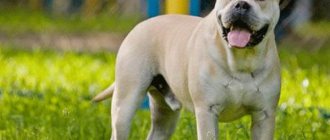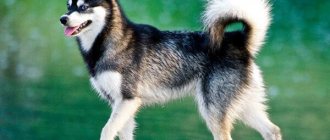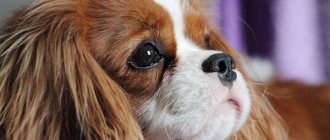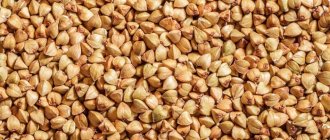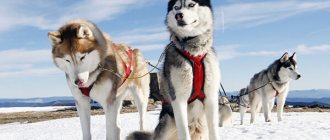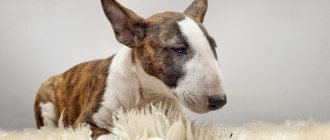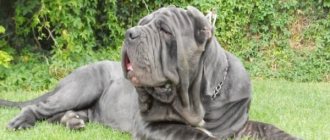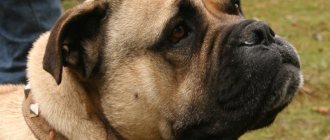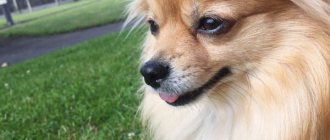Mastiffs are a large group of breeds that include Tibetan, English, French, German, Pyrenean, Major, American, Brazilian, Pakistani and other varieties of these dogs.
Spanish Mastiffs are large and strong dogs, the stern expression of their muzzle can terrify anyone who is not familiar with this breed.
In fact, it is simply impossible to say that they are ferocious. Once you get to know them better, their good-natured attitude and affectionate nature immediately become noticeable.
However, there are several features that everyone who is thinking about purchasing this dog should know in advance.
In the article you will find a description of this breed, its characteristics and features.
History of the breed
There are many versions of the origin of Spanish mastiffs, but only 2 of them are the most reliable. Some scientists say that the ancestors of these dogs were brought to Europe by Phoenician merchants, others are inclined to believe that they owe their appearance here to Asian nomads.
Mastiffs are similar to Turkish, Caucasian, Balkan and Tibetan shepherd dogs, so it is impossible to reliably determine which of them is the ancestor of the Spanish mastiffs, but it is likely that all these breeds have common roots.
It is known that Spanish mastiffs existed as a separate breed back in the 15th century. and were engaged in grazing cattle in the Pyrenees.
NOTE!
This dog breed became widely known only at the beginning of the 20th century, and the first standard was determined at the end of the Second World War. Having gained international recognition, Spanish Mastiffs became even more popular, but were still inferior to German Shepherds and Rottweilers.
Spanish mastiffs were brought to Russia in the mid-90s from a Czech nursery.
Interesting Facts:
- Until 1929, this breed was called a little differently - “mountain Spanish mastiff”.
- Spanish shepherds, who still use these dogs as workers, say that they are invincible - they never succumb to wolves and always win in a fight.
- These are dogs of late maturation: males reach maturity by three years, females by two.
Mating
Breeding moloss is not an easy task and difficulties arise during the process. It will take a lot of free space and physical effort.
Large dogs mature at 25-30 months. A girl's first heat begins earlier, at about 8-12 months. Mating is carried out starting from the 3rd heat. It is necessary to contact a kennel or dog breeding club in advance to find a suitable male. Thanks to this, future puppies can be included in the breed book and given official documents. 2 weeks before mating, animals must be cleared of worms and parasites, and also be examined by a veterinarian.
On the chosen day, the dogs are introduced and brought together in the male’s territory or in a neutral place. During this time, the animals sniff and get used to each other. If the female does not allow mating, then it is better to postpone the mating to the next day.
During the process, it is necessary to hold the girl under her stomach, and direct the boy into the noose. After 2 days, the mating is repeated to consolidate the result.
Read a detailed article on the topic: “Everything you need to know about breeding dogs: appropriate age, what to do if it doesn’t work out, rules and tips.”
Description and standard
Spanish Mastiffs are large, strong, proportionally built dogs. When you see representatives of this breed, you cannot help but notice their grace and grandeur. The sense of dignity of these dogs can be read in their entire appearance - from their posture and gaze to their demeanor in public and their unfettered, swift, free movements.
Characteristics of the breed standard:
- the head is large, but harmonious relative to the body;
- the transition from the forehead to the expressive, powerful muzzle is weakly expressed;
- the skin is thick, does not fit tightly;
- rectangular body;
- the chest is powerful and deep;
- The loin is wide and powerful, the croup is muscular;
- the shoulder and shoulder blades are wide;
- the stomach does not sag slightly due to the large volume of skin;
- limbs are strong, straight, set wide and parallel to each other, the hind limbs are more powerful;
- paws are large, oval;
- powerful jaws, scissor bite;
- the nose is large and black;
- eyes oval, brown;
- there are wrinkles on both sides of the eyes, giving the dog a serious appearance;
- The ears are triangular, hanging, set wide and low.
The coat is of medium length, thick, close to the body, slightly wavy, the undercoat is thick and dense.
Character traits
By the appearance of these dogs one can judge their endurance and performance.
Despite their impressive size, which can frighten people unfamiliar with this breed, Spanish mastiffs have a calm, even and balanced character, while they are not devoid of self-esteem and feel superior to others.
The Spaniards are not aggressive and will never attack without a good reason. Outwardly, they seem melancholy and indifferent to everything, but this instantly changes as soon as the dog sees a threat.
Representatives of this breed behave calmly, affectionately and gently with the owner and other family members. They become reliable and devoted friends and faithful helpers. Spanish Mastiffs need their owner's attention, love and care.
These dogs get along well with children, become their nannies and protect them from dangers. They tolerate children's pranks and take part in games with pleasure.
The Spaniards do not have problems with other animals either - they are friendly towards other dogs, and for them cats, livestock and small pets are part of the owner’s property, which they consider it their duty to preserve and protect.
Expert opinion
Kozhevin Semyon Kirillovich
Expert dog handler.
Spanish mastiffs are absolutely not characterized by causeless aggression, anger and disobedience. These are good-natured and calm dogs, attached to their family and the territory entrusted to them - they do not try to escape by digging or jumping over a fence. However, in order for a dog to show its best qualities, it is necessary to make some efforts and seriously engage in its upbringing - an untrained and unsocialized Spanish Mastiff can be a threat, since not everyone can cope with it.
Training
Many owners, when characterizing Spanish mastiffs, will state their amazing mental and intellectual abilities. But none of the happy owners of Spaniards will say that their pets do not need to be raised. Therefore, despite the fact that these dogs are neither service nor sport dogs, training is necessary for the Spanish Mastiff from early puppyhood until gray hair.
Breeders with experience in breeding and keeping mastiffs know that behind the external equanimity of their pets lies the spirit of a strong fighter and guard. Nobody wants to be the owner of a hundred-kilogram ill-mannered dunce from whom you don’t know what to expect.
Therefore, the Spanish Mastiff must be a controllable dog, and for this he must be trained in the rules of good manners so that his owner can control his dog in any, even the most difficult situation. It would be best to carry out training and any learning processes under the supervision and assistance of a specialist.
Mastiffs are extremely intelligent and receptive to praise and training, so training them will not be onerous.
Advantages and disadvantages
Loyalty and affectionate disposition are not all the advantages of Spanish mastiffs.
The advantages of this breed include:
- courage;
- endurance and performance;
- intelligence and learning ability;
- patient and unobtrusive disposition;
- ability to get along with other animals and children.
Minuses:
- stubbornness;
- need for constant attention;
- the need for physical activity;
- heavy shedding;
- not suitable for apartment living;
- late emotional maturation.
Puppies receive temperament at birth, but character development takes about 4 years. It is believed that Spanish Mastiffs are dogs that take a long time to mature, so most of the shortcomings of these dogs are associated with improper upbringing.
Health
The Spanish giant's health is quite strong, as it has a good immune system. However, like all large breeds, it has a number of predispositions, such as :
- Dermatitis and allergies.
- Gastrointestinal disorders.
- Eye diseases.
- Dysplasia.
- Eczema.
With good care and prevention, as well as sufficient physical activity, the dog can live a long life. Therefore, it is very important to pay attention to problems in a timely manner and regularly visit the veterinarian for preventive examinations.
Photos of colors
For Spanish Mastiffs, almost any coat color is acceptable. Most often, representatives of the breed are found with yellow-cream, black, brindle, fawn and white-black coat.
Is it suitable for living in an apartment or outdoors?
Spanish Mastiffs cannot be kept in an apartment; they need space.
Dense coat and thick undercoat allow these dogs to withstand both heat and cold without problems, so the most suitable option is a heated indoor enclosure and regular walks outside the site.
IMPORTANT!
These dogs should not be kept on a chain. They need constant contact with a person and the opportunity to splash out energy.
Walks
For the Spanish Mastiff - a dog, as already mentioned, of quite impressive size - long, but not burdensome walks in nature are necessary. This pet is not suitable for active athletes. Excessive stress can damage the joints and ligaments of a huge animal.
You need to be especially careful with puppies when the formation and growth of bones, muscles and ligaments occurs. However, regular swimming is beneficial for them. Water will relieve excess stress, but will keep the body moving.
How to properly care?
Caring for representatives of this breed is not difficult, the main thing is to accustom your pet to hygiene procedures from childhood and carry them out regularly.
Wool and bathing
You need to brush your dog with a metal brush 2-3 times a week, and daily during the shedding period.
After each walk, you need to wash your pet’s paws and belly, and give him a full bath no more than once a quarter, using a special shampoo that matches his coat type.
Claws
With regular and long walks, the Spanish Mastiff's claws grind down to the required length on their own. If this does not happen, they need to be trimmed with a nail clipper about 1-2 times a month, and the sharp edge should be filed with a nail file.
NOTE!
If your pet has dewclaws, the claws on them must be shortened yourself, since they do not grind down.
Ears and eyes
Ears should be wiped once a week with a damp cloth to get rid of dirt and dust, and accumulated wax should be removed with a cotton swab.
The eyes should be examined for inflammation and increased lacrimation, and wiped with a cotton pad in the morning, removing any secretions that have accumulated overnight.
Preparation for the exhibition
Some owners lead very eventful lives with their pets. We are talking about visiting exhibitions. In order for the dog’s coat to look well-groomed, they should be bathed well in advance of the event, since the fatty lubricant is restored only after 2-3 days. In addition, a few hours before the exhibition, it is recommended to treat the wool with a spray texture specially designed for this purpose. It significantly improves the appearance of fur, gives it shine, restores volume and refreshes it.
In winter, when exhibitions are held frequently and it is not recommended to bathe dogs, the Spanish Mastiff with its thick coat really needs to be thoroughly cleansed from various types of contaminants. In such cases, dry shampoo is used. It is very convenient to use, in addition, it does not have any harmful effects on the animal’s skin and has a fairly pleasant smell.
This shampoo is sold in the form of a spray, powder or powder. After using it, you just need to comb the fur thoroughly. It must be said that shampoos that contain conditioner or protein are preferable to choose. After using it, the dog will look neat and well-groomed, and the coat will gain volume and a beautiful shine.
And finally, advice: you need to start caring for Spanish Mastiff dogs, photos of which are presented in this article, from an early age so that, as puppies, they get used to various cosmetic procedures. Then the animals will be calm, and their owners will be happy.
Life expectancy and major diseases
Spanish mastiffs are strong and hardy dogs with a fairly strong immune system, however, they also have a number of breed diseases. Such pathologies are the result of many years of selection and are often inherited.
The most common diseases:
- hip dysplasia;
- volvulus;
- gonarthrosis;
- cataract;
- entropion of the eyelid;
- third eyelid adenoma;
- eczema;
- bursitis.
The average life expectancy of representatives of this breed is 12-15 years.
Dossier
Adult dog height: 77 cm. Weight: 90 kg. Characteristic color: plain of any shade. Coat length: medium. Life expectancy: up to 11 years. Advantages of the breed: good guard, smart, loyal, does not require any special care. Difficulties of the breed: suitable for living in a private home, requires education and training. Average price of a Spanish Mastiff : $500-4000. Classification: large, security guard.
How and what to feed?
In order for a dog to grow healthy and develop properly, it needs to be provided with proper, balanced nutrition, including the required amount of proteins, fats, carbohydrates, vitamins and minerals.
The diet of Spanish mastiffs can be based on both natural products and industrial feeds, the main thing is not to mix both types of food, as this can lead to problems with the gastrointestinal tract and cause an excess or deficiency of minerals.
Each type of nutrition has its own advantages and disadvantages.
Thus, a natural diet is varied and eliminates the possibility that the dog will get bored with food. In addition, all products included in the dog’s menu will be fresh and of high quality, since their choice is the responsibility of the mastiff owner.
Also, with a natural diet, all nutrients and minerals are better absorbed, and if an allergic reaction occurs, there is no need to completely change the dog’s diet; it is enough to eliminate the product that provoked it.
But such nutrition has significant disadvantages - it requires certain knowledge about preparing a diet and quite a lot of time preparing food for the dog.
Industrial feeds have a balanced composition and are enriched with essential vitamins and minerals. In addition, manufacturers have developed special lines of food that take into account the age, health status and activity level of dogs.
The finished product is easy to use and dose, it has a long shelf life and saves time on food preparation.
When choosing food for Spanish mastiffs, you should give preference to premium or super premium products. The most popular food brands are Brit Premium, Brit Care, Flatazor, Acana, Royal Canin.
Cuttlefish shell (sepia)
The cuttlefish shell is also a high calcium product, it contains up to 35% of this element.
This is nothing more than the skeleton of a cuttlefish. It is most often sold as a mineral supplement for parrots. The cost varies - from 60 to 120 rubles for 1 shell, depending on the point of sale.
The shell can be placed in the terrarium whole or in large pieces; the snails will gnaw it. My Chamomile, when she was little, loved to chew it in large pieces, but over time she stopped liking this product and practically stopped chewing it. Therefore, now I add sepia either in crushed form or in small pieces, so as not to simply transfer the product. In conditions of high humidity in the terrarium, the shell softens, darkens, and the snail completely refuses to eat it. She prefers only white, fresh and crisp sepia.
Cuttlefish shell
It is necessary to check the shell for saltiness before giving it to the snail. Cuttlefish is a marine animal, so its skeleton has a certain salinity due to salty sea water. If the shell is salty, it can be washed in cold running water and then dried.
When purchasing sepia, pay attention to its naturalness. Sometimes sepia for parrots is sold with flavorings or dyes, which is absolutely not suitable for snails
Buy natural white shell without additives.
Permitted and prohibited products
The natural diet of Spanish Mastiffs should consist of:
- lean meat;
- fermented milk products;
- rice and buckwheat cereals;
- boiled eggs;
- vegetables, fruits and herbs;
- sea fish.
IMPORTANT!
The natural menu must be supplemented with a vitamin and mineral complex.
Representatives of this breed are prohibited from giving:
- smoked meats;
- canned food;
- marinades, pickles, spicy and fried foods;
- fat meat;
- river fish;
- bones;
- confectionery;
- pasta;
- potato;
- legumes;
- chocolate;
- seasonings and spices;
- sausages.
You should also not feed your dog food from the common table.
Number and size of servings
After weaning from its mother, the dog should be fed strictly in accordance with the regimen. The number of feedings depends on the age of the pet:
- 2-3 months – 6 times;
- 4-5 months – 5 times;
- 6-9 months – 3 times;
- 9 months and older – 2 times.
An adult Spanish Mastiff eats about 1-1.5 kg of food per day; this amount of food must be evenly distributed over several feedings .
Feeding
The Spanish Mastiff is a fairly expensive dog to keep. His ancestors were working animals with excellent metabolism, which has been fully passed on to modern animals. Owners should immediately forget about the budget menu.
The strong and heavy skeleton of these dogs will require a huge amount of building material for its formation. Mastiff puppies grow quickly early in their lives, so they will need a high-quality, nutritious food. A one and a half month old baby should receive balanced nutrition 6 times a day, and dry food will not be enough here.
During the period of active growth, experts recommend adding more fresh meat (lean beef), dairy products (kefir, cottage cheese), boiled vegetables (except potatoes) and fruits to the diet. It is better to soak dry puppy food in warm water.
You should be careful about mixed feeding. And if the puppy does not tolerate it well, then it is better to exclude dry food from the diet and switch to natural food. It is important to adhere to the same diet as the breeder had during the first month of life in the new home.
At the same time, it is necessary to ensure that the dog does not overeat. Excess weight is an extra load on the joints and ligaments and the rest of the musculoskeletal system. For the same reason, it is necessary to monitor the puppy’s activity, not allowing him prolonged physical activity, but also not prohibiting him from moving.
It is very important that from the first days of being in the house the dog knows exactly where he can always find fresh water to drink. At the same time, you need to make sure that the puppy does not play with the water dish or overturn it, otherwise this game will be almost impossible to stop later.
A feature of dogs of this breed is their slow maturation, which lasts up to 2.5-3 years. While the animal is gaining mass, its behavior is that of a puppy. And nutrition during this period should be appropriate.
It is enough to feed an adult dog twice a day. Even if an adult pet eats dry food, it should still receive lean meat: chicken, horse meat or beef. The most important thing is not to overfeed!
How to choose a puppy? Boy or girl?
When choosing a puppy, it is necessary to inspect the conditions of its detention - it is impossible for the puppy to be kept in a closed room, much less in an enclosure, since the ability to move freely minimizes the risk of developing problems with the musculoskeletal system.
Also, the puppy should have powerful and strong bones, a scissor bite, and the length of the facial part of the head should not exceed the length of the skull.
The future pet should not have rashes, irritations, rashes, dandruff, or excess weight.
NOTE!
The coat will become slightly lighter with age.
It is necessary that the puppy is cheerful, active, inquisitive, has a good appetite and does not show aggression.
When making a choice between a bitch and a dog, you should remember that girls have a calmer and more flexible character, while boys are stubborn and self-willed. If you have plans to breed a breed, you need to purchase a female; if you plan to have an exhibition career, you need to purchase a male.
Nurseries in Russia and the CIS
There are quite a lot of nurseries specializing in breeding Spanish mastiffs, these are just a few of them:
- “Don Mastin”, Tver region, pos. Dorino;
- Madridsky Dvor, Moscow;
- SPANISH GRAND, Moscow;
- “Giant Pets”, St. Petersburg;
- "Moonlight", Donetsk. Ukraine;
- Bene Vertan, Moscow region, Marusino village;
- Great Golden Leon. Moscow city.
Representatives of this breed are not cheap, so it is better to purchase them from trusted breeders who value their reputation. Otherwise, there is a risk of buying a sick puppy or mixed breed.
Price range
How much a Spanish Mastiff puppy costs depends on its class. So, a pet-class representative will cost 35-45 thousand rubles, for a breed-class puppy you need to pay 50-70 thousand rubles, and a show-class dog costs on average 80-150 thousand rubles.
Of course, you can find a puppy much cheaper on the market or through an advertisement, but in this case there is no guarantee that it is a purebred representative of the breed without physical or mental disabilities.
